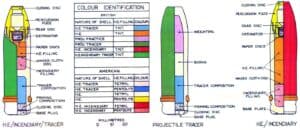A 20 millimetre by 120 millimetre round meant for anti-armour operations and missile defence systems.
The Oerlikon 20 mm cannon is a series of autocannons, based on an original German Becker Type M2 20 mm cannon design that appeared very early in World War I. It was widely produced by Oerlikon Contraves and others, with various models employed by both Allied and Axis forces during World War II. Many versions of the cannon are still used today.
During World War I, the German industrialist Reinhold Becker developed a 20 mm caliber cannon, known now as the 20 mm Becker using the advanced primer ignition blowback (API blowback) method of operation. This used a 20×70mmRB cartridge and had a cyclic rate of fire of 300 rpm. It was used on a limited scale as an aircraft gun on Luftstreitkräfte warplanes, and an anti-aircraft gun towards the end of that war.
Because the Treaty of Versailles banned further production of such weapons in Germany, the patents and design works were transferred in 1919 to the Swiss firm SEMAG (Seebach Maschinenbau Aktien Gesellschaft) based near Zürich. SEMAG continued development of the weapon, and in 1924 had produced the SEMAG L, a heavier weapon (43 kg) that fired more powerful 20×100mmRB ammunition at a slightly higher rate of fire, 350 rpm.
In 1924 SEMAG failed. The Oerlikon firm, named after the Zürich suburb of Oerlikon where it was based, then acquired all rights to the weapon, plus the manufacturing equipment and the employees of SEMAG.



